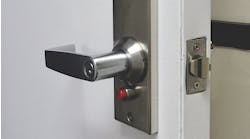Years ago, it was easy for students and others to breach the security at a college residence hall. Just wait for the guard at the front desk to nod off or be distracted, and scoot through the entrance into the facility. Or find a door out of sight of the security staff and sneak in.
Unfortunately, those breaches may lead not only to innocuous student pranks, but also to serious crimes, including theft, assault and homicide. So as parents and students pressure colleges and universities to bolster their protection of a student's home away from home, school administrators are turning increasingly to technology to provide more sophisticated ways to make a campus safe.
Growing acceptance of security measures such as access-control cards, video surveillance and biometric devices allows schools to protect students and their belongings more effectively.
A swipe for security
Using magnetic-stripe or proximity cards to enhance security on a college campus has become widespread. Most students already carry identification cards, so schools could add security systems onto a card without having to get students accustomed to carrying a card. Swiping a card through a reading device could keep unauthorized people out of facilities and monitor who is in a facility. Lost cards could be deactivated as soon as they were reported to campus security, so the expense of re-keying locks is greatly diminished. Specific access privileges could be set for a student depending on his or her schedule.
Randolph-Macon College in Ashland, Va., began installing a swipe-card system at residence halls for the 2001-2002 school year. It replaced a system that used a numeric keypad to control entry to residence halls. Keypad systems had provided, at least theoretically, a step up from security that relied on keys and human monitors. Keys can be lost or illegally duplicated, and the effectiveness of workers monitoring residence-hall entrances, often students working part-time, fluctuated with their ability to stay awake.
But systems that used a common entrance code for all residents eventually raised this philosophical question: How many people have to learn a secret code before it no longer is considered a secret?
“Before our card-swipe system was installed this year, we had punch codes to get into the residence halls,” says Jamey Campbell, coordinator of residence life at Randolph-Macon. “Pretty soon, you had everybody from the Ashland police to the Domino's delivery guy knowing the code.”
As swipe cards become more sophisticated, they can serve many functions for students beyond residence-hall access.
“The IDs also control students' access to the library and dining hall,” says Campbell. “They also have a limited use as a debit card for vending machines and laundry facilities.”
Access-control systems typically include alarms on doors away from the main entrance, so that security personnel can determine if a door has been propped open and is jeopardizing the building's security. At Randolph-Macon, some students who objected to the alarms on out-of-the-way doors vandalized the system by cutting the alarm wires. Campbell says the school is looking at making such vandalism more difficult by obscuring the conduit for the security system behind drop-in ceilings.
Video vigilance
Situated in a city neighborhood in Kansas City, Mo., Rockhurst University tries to balance the desire for its students to be involved in the community with its need to provide student residents with a safe environment for living and learning.
It has equipped its residence halls with a card system that controls access at the main building entrance, as well as elevators and stairwell doors. In addition, the school has installed closed-circuit cameras at the front entrances of its residence halls and in the hallways of each floor.
“It has worked real well,” says Bill Evans, director of safety and security at Rockhurst. “It helps in preventing incidents from happening, and if something does happen, it's a great investigative tool.”
As safety concerns have grown, and technology has made video surveillance more prevalent in society, students have become more accepting of the presence of security cameras.
“Fifteen years ago, if I had suggested installing closed-circuit cameras, they would have run me out of here on a rail,” says Evans. “When we first started installing the cameras, we heard from some students that it was an invasion of privacy. This summer, we're installing cameras in the hallways in our last dorm, and what we've been hearing is, ‘Why don't we have them yet?’”
Getting the upper hand
Schools that use swipe cards have greater control of who enters and exits a residence hall. But if a card ends up in the wrong hands and is not reported missing, an unauthorized person could gain entry to student housing.
To prevent that situation, officials at the University of Georgia in Athens have added another layer of protection onto the school's swipe-card system: hand readers. Handreading devices are one form of biometrics, which uses technology to measure body characteristics, such as fingers, faces or voices, as a means of identification.
When students enroll at the University of Georgia, measurements of their right hands are recorded and stored in a computer database, says Ben George, a coordinator in the school's housing department. A student wanting to enter a residence hall must swipe his or her ID card through a reader (or punch in a personal ID code onto a numeric keypad) and place the right hand in a reading device.
If the handprint and ID card do not match, the guard on duty 24 hours a day at residence-hall entrances will prevent that person from entering the building.
“We've had hand readers for several years,” says George. “I've never heard any complaints from students. And it's an important issue for parents concerned about campus safety.”
Kennedy is staff writer for AS&U.

